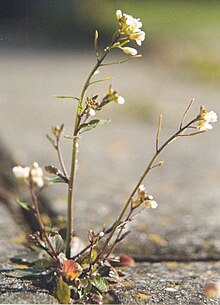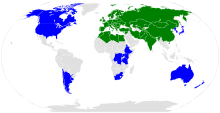
Back رشاد أذن الفأر Arabic رشاد اذن الفار ARZ Arabidopsis thaliana AST Arabidopsis thaliana BS Arabidopsis thaliana Catalan Arabidopsis thaliana CEB Huseníček rolní Czech Berwr y fagwyr Welsh Almindelig gåsemad Danish Acker-Schmalwand German
| Arabidopsis thaliana | |
|---|---|

| |
| Scientific classification | |
| Kingdom: | Plantae |
| Clade: | Tracheophytes |
| Clade: | Angiosperms |
| Clade: | Eudicots |
| Clade: | Rosids |
| Order: | Brassicales |
| Family: | Brassicaceae |
| Genus: | Arabidopsis |
| Species: | A. thaliana
|
| Binomial name | |
| Arabidopsis thaliana | |

| |
The range of Arabidopsis thaliana.
| |
| Synonyms[1] | |
|
Arabis thaliana | |
Arabidopsis thaliana, the thale cress, mouse-ear cress or arabidopsis, is a small plant from the mustard family (Brassicaceae), native to Eurasia and Africa.[2][3][4][5][6][7] Commonly found along the shoulders of roads and in disturbed land, it is generally considered a weed.
A winter annual with a relatively short lifecycle, A. thaliana is a popular model organism in plant biology and genetics. For a complex multicellular eukaryote, A. thaliana has a relatively small genome of around 135 megabase pairs.[8] It was the first plant to have its genome sequenced, and is an important tool for understanding the molecular biology of many plant traits, including flower development and light sensing.[9]
- ^ Warwick SI, Francis A, Al-Shehbaz IA (2016). "Brassicaceae species checklist and database". Species 2000 & ITIS Catalogue of Life (26 ed.). ISSN 2405-8858. Archived from the original on 9 December 2018. Retrieved 1 June 2016.
- ^ "Arabidopsis thaliana". Germplasm Resources Information Network. Agricultural Research Service, United States Department of Agriculture. Retrieved 11 December 2017.
- ^ Hoffmann MH (2002). "Biogeography of Arabidopsis thaliana (L.) Heynh. (Brassicaceae)". Journal of Biogeography. 29 (1): 125–134. Bibcode:2002JBiog..29..125H. doi:10.1046/j.1365-2699.2002.00647.x. S2CID 84959150.
- ^ Mitchell-Olds T (December 2001). "Arabidopsis thaliana and its wild relatives: a model system for ecology and evolution". Trends in Ecology & Evolution. 16 (12): 693–700. doi:10.1016/s0169-5347(01)02291-1.
- ^ Sharbel TF, Haubold B, Mitchell-Olds T (2000). "Genetic isolation by distance in Arabidopsis thaliana: biogeography and postglacial colonization of Europe". Molecular Ecology. 9 (12): 2109–2118. Bibcode:2000MolEc...9.2109S. doi:10.1046/j.1365-294x.2000.01122.x. PMID 11123622. S2CID 1788832.
- ^ Krämer U (March 2015). "Planting molecular functions in an ecological context with Arabidopsis thaliana". eLife. 4: –06100. doi:10.7554/eLife.06100. PMC 4373673. PMID 25807084.
- ^ Durvasula A, Fulgione A, Gutaker RM, Alacakaptan SI, Flood PJ, Neto C, Tsuchimatsu T, Burbano HA, Picó FX, Alonso-Blanco C, Hancock AM (May 2017). "Arabidopsis thaliana". Proceedings of the National Academy of Sciences of the United States of America. 114 (20): 5213–5218. doi:10.1073/pnas.1616736114. PMC 5441814. PMID 28473417.
- ^ "Genome Assembly". The Arabidopsis Information Resource. Archived from the original on 7 March 2021. Retrieved 29 March 2016.
- ^ "Nifty 50: ARABIDOPSIS -- A PLANT GENOME PROJECT". www.nsf.gov. Retrieved 10 February 2023.
© MMXXIII Rich X Search. We shall prevail. All rights reserved. Rich X Search